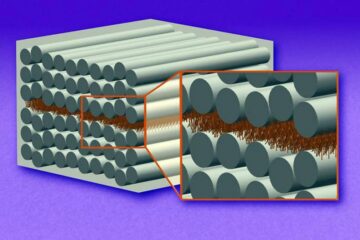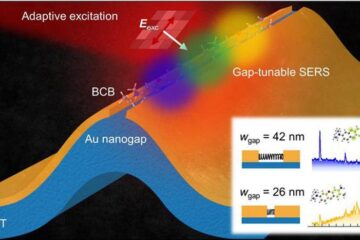Magnetic fields on a conveyor belt

The scientists lead by Dr. Carsten Hucho found a way to move smallest possible magnetic entities – so-called flux quanta – with the help of acoustic waves. Their results may open new ways to process data. The study is published in the Journal Solid State Communications (Vol. 142, p. 212).
Currently, electrons are used to transport information and process data but scientists are looking for alternatives. One possibility is the use of the magnetic properties of electrons, the so-called spin. Another avenue is the magnetic flux. „You cannot pin down single electrons“, says Carsten Hucho, „and their spin-orientation is not permanent.” Both problems can be avoided by using flux quanta in superconductors. These tiny magnetic fields, also called vortices, remain stable for a long time – theoretically infinite. ”We can keep track of an individual flux quantum – and now we can move the flux around”, says Hucho.
The scientists at PDI managed to transport magnetic flux quanta with a surface acoustic wave. The vortices move with the soundwave like on a conveyor-belt. So will these new findings accelerate the development of so-called “fluxtronics” after electronics and spintronics? Hucho cautions that “there is still a long way to go.” The main goal of the study was to show that magnetic flux quanta in superconductors can be manipulated in a well-defined way.
This possibility of manipulating the vortex motion and vortex density by a dynamic external parameter has far-reaching technological consequences besides the storage and processing of data. For instance, tiny magnetic particles could be transported in some sort of conveyor belt. “This would be of interest for molecular analytics in a so-called lab on a chip”, says Hucho.
Media Contact
More Information:
http://www.fv-berlin.deAll latest news from the category: Physics and Astronomy
This area deals with the fundamental laws and building blocks of nature and how they interact, the properties and the behavior of matter, and research into space and time and their structures.
innovations-report provides in-depth reports and articles on subjects such as astrophysics, laser technologies, nuclear, quantum, particle and solid-state physics, nanotechnologies, planetary research and findings (Mars, Venus) and developments related to the Hubble Telescope.
Newest articles

“Nanostitches” enable lighter and tougher composite materials
In research that may lead to next-generation airplanes and spacecraft, MIT engineers used carbon nanotubes to prevent cracking in multilayered composites. To save on fuel and reduce aircraft emissions, engineers…

Trash to treasure
Researchers turn metal waste into catalyst for hydrogen. Scientists have found a way to transform metal waste into a highly efficient catalyst to make hydrogen from water, a discovery that…

Real-time detection of infectious disease viruses
… by searching for molecular fingerprinting. A research team consisting of Professor Kyoung-Duck Park and Taeyoung Moon and Huitae Joo, PhD candidates, from the Department of Physics at Pohang University…





















